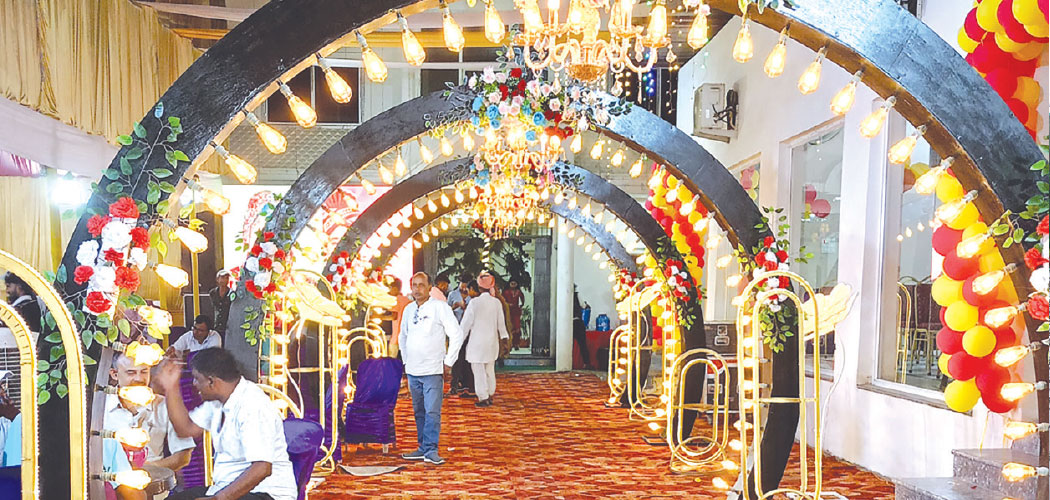
SATV 14 May, Kathmandu: The government has introduced laws aimed at regulating and controlling wedding expenses. Initially, it implemented the Social Behaviour Reform Act, 1976 and later enacted the National Criminal Code, 2017 which includes specific provisions regarding dowry.
These laws outline the nature and limits of dowry transactions and provide penalties for violations. However, despite these legal frameworks, dowry practices and extravagant wedding expenditures are not decreasing. In fact, they appear to be on the rise. Regulatory bodies often remain passive observers, with many of their representatives themselves attending and participating in such lavish ceremonies.
The months from November to June are considered peak wedding season in Nepal. During this time, weddings are taking place in nearly every household, among friends or in the neighborhood. What was once a family ritual has now become a display of social status.
According to advocate Doman Sah, excessive competition in wedding expenditures is being fueled by extravagant decorations, brightly lit tents, expensive dowries, grand feasts and videography. While wealthy families may not be affected, such costs are placing an immense financial burden on lower- and middle-income families.
Arjan Kumar Mandal from Janakpurdham said, “People talk about how a wedding was conducted for months. That’s why there’s a mindset that a grand event must be held, even if it means taking out a loan.” He added, “It’s become a belief that a wedding isn't respected unless it includes cars, fruits, decorations and a warm welcome.”
Social activist Sunita Kranti pointed out the hypocrisy of some ethnic leaders who advocate publicly against dowry and unnecessary spending in community events, but are themselves involved in extravagant weddings with heavy dowry exchanges. Although some organisations in Janakpur, Lahan and Rajbiraj have announced awards for those who conduct dowry-free weddings, implementation has been weak. She said that while many respected individuals claim to have conducted ideal, dowry-free weddings, they often accept large amounts of dowry in private.
There is no legal cap on dowry amounts. Dowries are often negotiated based on the groom’s education, employment and property. If the groom is highly educated and has sufficient assets, dowries can range from Rs. 1 million or more, with the bride’s family typically spending even more on the feast, tent, decorations and entertainment. Combined, wedding costs can range from a minimum of Rs. 1.5 million to as much as Rs. 10 million.
Legal provisions on dowry
While traditional gift exchanges at weddings are not entirely prohibited, deeply rooted customs such as dowry and ‘tilak’ are still prevalent. According to Section 174 of Chapter 11 (Offenses Related to Marriage) under Part 2 (Criminal Offenses) of the National Criminal Code, 2017, provisions have been made regarding transactions in marriage. Its Subsection (1) prohibits the demand or conditional exchange of any movable, immovable property or dowry, except for small customary gifts and jewelry worn by the bride or groom.
Likewise, Subsection (2) states that violations can result in imprisonment of up to three years, a fine of up to Rs. 30,000 or both. Subsection (3) further stipulates that if someone demands dowry after marriage or harasses or mistreats the bride or her relatives for not receiving it, they may face up to five years in prison, a fine of up to Rs. 50,000 or both.
Legally, both the giver and receiver of dowry can be penalised. However, in the Tarai–Madhes region, dowry remains deeply embedded in the culture, according to legal professionals.
Measures to reduce dowry and wedding expenses
Several strategies can help curb dowry and excessive wedding spending. Promoting simple and low-cost mass weddings at the community level can reduce financial pressure on families. Encouraging inter-caste marriages, court marriages, or simple temple ceremonies also promotes equality and minimizes unnecessary expenses. Providing recognition, incentives, or tax exemptions to families that reject dowry serves as a positive reinforcement. Additionally, setting standards for decorations, tents and entertainment through local government regulations can help limit extravagant displays. Public awareness campaigns through radio, television, and school curricula can further educate people about the legal consequences and social harms of dowry practices.



















